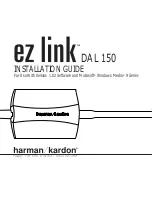
AC75 Hardware Interface Description
Strictly confidential / Preliminary
s
AC75_HD_V00.202
Page 109 of 120
27.04.2006
7 Sample
Application
Figure 46 shows a typical example of how to integrate a AC75 module with a Java
application. Usage of the various host interfaces depends on the desired features of the
application.
Audio interface 1 demonstrates the balanced connection of microphone and earpiece. This
solution is particularly well suited for internal transducers. Audio interface 2 uses an
unbalanced microphone and earpiece connection typically found in headset applications.
The charging circuit is optimized for the charging stages (trickle charging and software
controlled charging) as well as the battery and charger specifications described in Section
3.5.
The PWR_IND line is an open collector that needs an external pull-up resistor which
connects to the voltage supply VCC µC of the microcontroller. Low state of the open collector
pulls the PWR_IND signal low and indicates that the AC75 module is active, high level
notifies the Power-down mode.
If the module is in Power-down mode avoid current flowing from any other source into the
module circuit, for example reverse current from high state external control lines. Therefore,
the controlling application must be designed to prevent reverse flow.
If the I
2
C bus is active the two lines I2CCLK and I2DAT are locked for use as SPI lines. Vice
versa, the activation of the SPI locks both lines for I
2
C. Settings for either interface are made
by using the AT^SSPI command.
The internal pull-up resistors (Rp) of the I
2
C interface can be connected to an external power
supply or to the VEXT line of AC75. The advantage of using VEXT is that when the module
enters the Power-down mode, the I
2
CI interface is shut down as well. If you prefer to connect
the resistors to an external power supply, take care that the interface is shut down when the
PWR_IND signal goes high in Power-down mode.
The USB interface has different functions depending on whether Java is running or not. It
can be used as debug interface for the Java environment; without Java it is a USB port. The
Java “System.out” channel may be routed to different outputs, such as ASC0, ASC1, USB, a
UDP port or the Flash File system. Delivery default is ASC1 (see sample application in
Figure 46). The AT^SCFG parameter “Userware/Stdout” can be used to determine the
interface used for “System.out” (see [1]).
The EMC measures are best practice recommendations. In fact, an adequate EMC strategy
for an individual application is very much determined by the overall layout and, especially,
the position of components. For example, mounting the internal acoustic transducers directly
on the PCB eliminates the need to use the ferrite beads shown in the sample schematic.
However, when connecting cables to the module’s interfaces it is strongly recommended to
add appropriate ferrite beads for reducing RF radiation.
Disclaimer
No warranty, either stated or implied, is provided on the sample schematic diagram shown in
Figure 46 and the information detailed in this section. As functionality and compliance with
national regulations depend to a great amount on the used electronic components and the
individual application layout manufacturers are required to ensure adequate design and
operating safeguards for their products using AC75 modules.












































